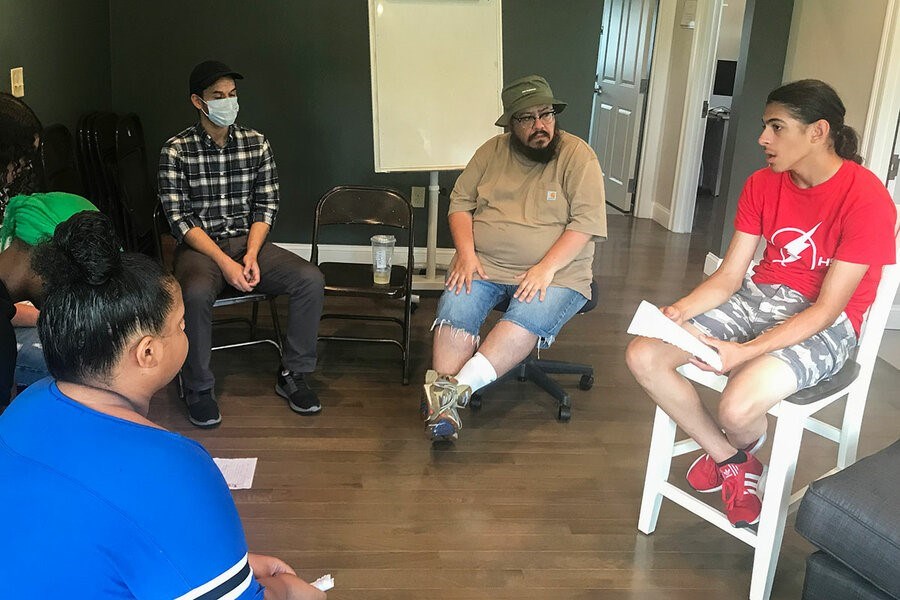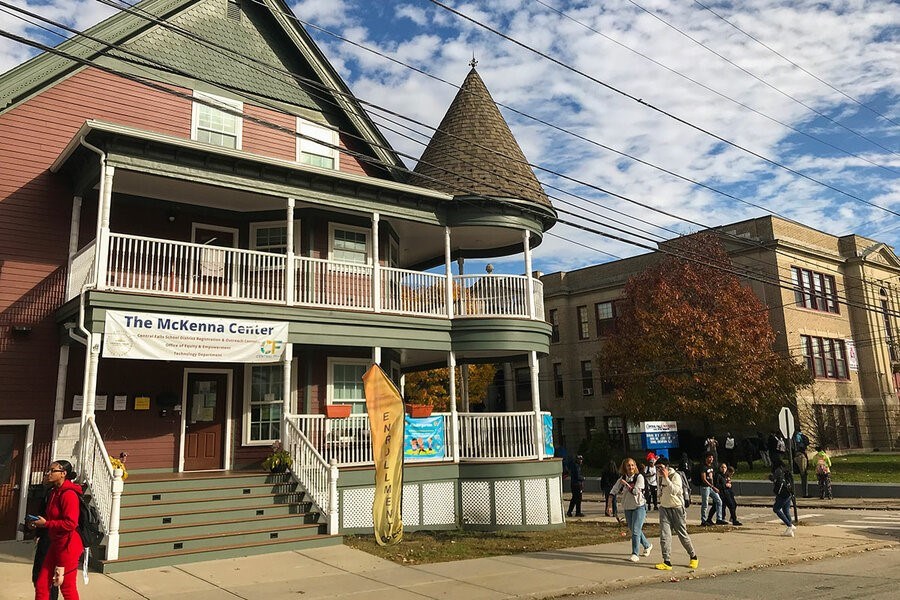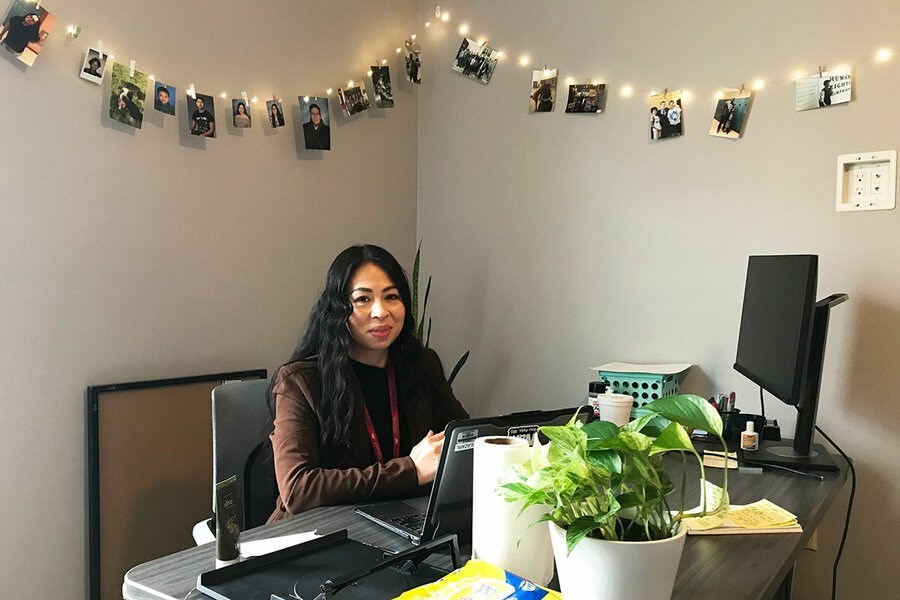Learning pods provided an alternative to in-person schooling for families who could afford it during the pandemic. Some public schools are taking the idea and using it as a tool to support a wider group of students.
CENTRAL FALLS, R.I. - With grape juice and Chex Mix at hand, and their little sister busy coloring nearby, Jenashia and Nevaeh Aponte settle down at a table with Sara Rubio, their “pod leader.”
It is late afternoon and the first floor of the McKenna Center – a renovated Victorian house located across the street from Central Falls High School in Rhode Island – is abuzz with teenagers chatting and catching up. But the sisters’ attention is squarely on Ms. Rubio: There are only four days left before teachers begin finalizing first-quarter grades, and the girls need her help.
Jenashia, a sophomore, pulls out a folder with her biology project, while her sister Nevaeh, a freshman, checks her grades online. Due to an illness in the family, she has missed the deadline to take her Algebra I portfolio exam. Her math teacher has just informed her that she will have to wait and take it next year.
“What’s his name?” asks Ms. Rubio. “Text me the dates you were out.”
Ms. Rubio, a junior at the University of Rhode Island who attended elementary school in Central Falls, has already intervened once this quarter. She’d noticed that Nevaeh was missing a grade in her online grade book for a major science project that the teen said she had completed. At Ms. Rubio’s urging, Nevaeh went to her teacher and they unraveled the mystery: She actually had turned in the assignment but had forgotten to write her name on it.
“She almost failed accidentally,” says Ms. Rubio.
Emerging at the height of the pandemic, pods (or “hubs” as they are sometimes called) were organized primarily by middle-class, college-educated parents and community groups to provide safe, supportive spaces for virtual learning. When education went online, pods took off – and then disappeared quickly as school buildings reopened around the country. Now, with federal stimulus dollars flowing and pressure building to accelerate student learning post-pandemic, some public school districts like Central Falls are trying new ways of pairing small groups of students with supportive adults.
While the number of districts currently operating pods or hubs is unknown, the Center on Reinventing Public Education, a nonprofit, created a database to track more than 300 pods in early 2021, finding that about 7% of the programs in this sample were run by districts. More recently, the data tracking firm Burbio identified 36 districts that are using pandemic relief funds to start hubs or hublike learning centers.
 Pod leaders Gus Rodriguez (left) and Will Navarro (center) meet with students in the living room of the McKenna Center in Central Falls, Rhode Island, in October 2022. Students are encouraged to set goals and advocate for changes that will help them attain them.Nancy Walser/The Hechinger Report
Pod leaders Gus Rodriguez (left) and Will Navarro (center) meet with students in the living room of the McKenna Center in Central Falls, Rhode Island, in October 2022. Students are encouraged to set goals and advocate for changes that will help them attain them.Nancy Walser/The Hechinger Report
One of the largest programs is in Guilford County, North Carolina. After school, staff and tutors work individually and in small groups of six or seven with teens deemed most at risk for not graduating. The hubs operate in all of the district’s 15 comprehensive high schools and serve 600 to 900 students weekly. Edgecombe County, also in North Carolina, uses pods to prepare 3-year-olds for kindergarten, and to work on projects that interest older students.
One of the more controversial efforts is unfolding in New Hampshire, where education officials set aside $6 million in federal stimulus funds to encourage the formation of both district-run and “community” pods as an alternative to traditional classrooms at the elementary level. The state has contracted with Prenda, an online education provider, to hire “guides” to supervise multiage pods of five to 10 children. While no district pods have opened yet, 35 community pods, serving about 200 students, are operating in family homes and other settings, according to New Hampshire Education Commissioner Frank Edelblut.
“We have got to at least try”
In Rhode Island, the pod program in Central Falls is among the country’s smallest but most ambitious. Launched in March 2021, it was envisioned as a way not only to help kids catch up academically, but also to create new job opportunities for residents of this largely immigrant, Hispanic community, and perhaps even inspire some to pursue teaching careers. Ten pod leaders serve five high schoolers each, meeting individually and as a group every week after school.
In addition to keeping tabs on homework and grades, pod leaders teach students how to manage their time, apply for summer jobs, and create goals for life after high school. They plan pizza parties, trips to museums, and visits to nearby places the students have never seen, like the seaside city of Newport. The program is expanding this year to include middle schoolers. A federal after-school grant worth $170,000 annually will help fund the program over the next five years.
A tiny city of just over 22,000, Central Falls was no stranger to hard times even before the pandemic. Thirty years ago, facing shortfalls and a limited tax base to fund its schools, city leaders handed financial control of the district over to the state. In 2010, Central Falls made national news again when the entire staff of the city’s only high school was fired as part of a “turnaround” effort to raise its perennially low test scores. A year later, the city filed for bankruptcy.
When schools shifted to remote learning in 2020, Superintendent Stephanie Downey Toledo watched another crisis unfolding. By Thanksgiving, nearly half of the city’s 800 high school students were failing two or more classes. Seventy-four students were failing five. More than half of the freshman class was chronically absent.
 The McKenna Center in Central Falls, Rhode Island, functions as a home for pods for high schoolers in the city's district, but pod leaders and students have the flexibility to decide where and when to meet to accommodate students’ schedules.Nancy Walser/The Hechinger Report
The McKenna Center in Central Falls, Rhode Island, functions as a home for pods for high schoolers in the city's district, but pod leaders and students have the flexibility to decide where and when to meet to accommodate students’ schedules.Nancy Walser/The Hechinger Report
Meanwhile, from her home nearby in the Boston suburb of Sharon, Massachusetts, Dr. Toledo, a mother of four, was fielding invitations to join private learning pods being organized by parents. “I mean, people were willing to cover the full salary of a teacher, and I just kept thinking, this would never be an option for the kids who I lead on behalf of,” she recalls.
So, in late 2020, when Shawn Rubin of the Highlander Institute, a professional development nonprofit, approached her about applying for a grant to set up pods in the district, she thought, “We have got to at least try.”
From the beginning, Mr. Rubin and Dr. Toledo agreed that the program would have a communitywide impact in this town, where the median household income was just $34,689 in 2020. Training was designed to provide pod leaders with activities they could use with students. Staff tapped into their networks to recruit the leaders, and reached out to students who might benefit, as well as to their parents. They started by inviting ninth graders deemed most “disengaged.”
Pod leaders, who are paid $20 an hour for 15 hours of work a week, must have a high school diploma or a GED diploma, some connection to the city, and be willing to attend weekly training sessions. Their most important role may be the consistent presence they provide, sometimes checking in with students daily by text, phone, video, or email, those involved in the program say.
Many of their students juggle jobs and babysitting duties for siblings. Some have chronic health conditions affecting their attendance, or struggle with lack of confidence, family conflicts, or trauma from losing loved ones. Pod leaders work to draw them out of their shell and get them involved in extracurricular activities that excite them and keep them going to school. The pod program is an “extra layer of support” for teachers who don’t have as much time to make deep connections with students, says Lesdin Salazar, the district’s director of equity implementation.
Pod leaders, whose backgrounds are often similar to those of their students, try to convey lessons they had to learn the hard way. Ms. Rubio’s parents came to the United States from Colombia. Because they didn’t speak English, they couldn’t help her with schoolwork. “I did all my work alone as a kid,” she says. “I had to figure it out on my own.”
Like other pod leaders, she worries the pandemic deepened her students’ feelings of isolation. She shares tips with the teens she works with on how they can communicate more effectively with peers and teachers and overcome the fear of looking “stupid” to ask for help when they need it. She plans to stick with her “beautiful” kids and see them through graduation.
“They’ve been through a lot,” she says. “They need a mentor.”
Will Navarro, one of the first pod leaders hired, grew up next door to the high school. He dropped out his senior year when he realized he was failing English and would not meet graduation requirements. Later, he earned a GED diploma. His mother, a single parent who worked double shifts in a factory when he was growing up, instilled in him a work ethic that he tries to encourage in his students.
 As director of equity implementation for the Central Falls district, Lesdin Salazar is one of several staffers helping to expand the pod program over the next five years. The pod program is an “extra layer of support” for teachers who don’t have as much time to make deep connections with students, she says.Nancy Walser/The Hechinger Report
As director of equity implementation for the Central Falls district, Lesdin Salazar is one of several staffers helping to expand the pod program over the next five years. The pod program is an “extra layer of support” for teachers who don’t have as much time to make deep connections with students, she says.Nancy Walser/The Hechinger Report
One of those students is Jason Summers. Mr. Navarro began working with Jason in May 2021. A ninth grader at the time, Jason was behind in all his classes. Over a span of three weeks, Mr. Navarro helped Jason get his grades up to at least 50% so he would qualify for summer school and not have to repeat courses the following year.
Now in 11th grade, Jason is on track to graduate. Still, sitting beside Mr. Navarro in the McKenna Center on a recent day, Jason admits to struggling with motivation. “Things have been rocky in school for me because I’ve just gotten lazy,” he says.
But, without the pods, Jason guesses he would still be a freshman or sophomore.
The pods have made a believer out of Denise Debarros, who has worked in the district for more than 20 years. In the past, she tried to connect homeless students to a tutoring program run by a local social services agency to help them boost their grades. But students wouldn’t go. She begged and cajoled, to no avail.
But the pods are different. “I saw them coming here,” she says of the students. “They like coming; I’m sold.”
For the most part, pod leaders are sticking around, too. Two have been promoted to full-time jobs within the school district.
But the pods are a work in progress. Robert McCarthy, principal at Central Falls High School, says he supports the program. But he had three veteran teachers leave over the summer, and with a number of vacant positions, he worries that the program is sometimes adding to, rather than reducing, teachers’ workloads.
“If teachers are getting messages from five or six different people who aren’t the parents, it becomes overwhelming,” he says.
Looking to the future
Whether pods are here to stay is an open question. David Dockterman, a lecturer at the Harvard Graduate School of Education who has studied past efforts to tailor learning to students’ individual needs, says the pods “seem like a good idea” as long they don’t marginalize students, and help accelerate learning.
Ultimately the future of pods may depend on whether they can be linked to improved test scores, he says, adding, “That’s where the pressure is.”
Proponents of pods are encouraged by student survey results and other data to date. Kathryn Rose, a registered nurse who runs two community pods out of her home in Goffstown, New Hampshire, says pods are a much-needed alternative for students who aren’t succeeding in traditional classrooms, including students who suffer extreme anxiety or have disabilities such as autism.
These students are “thriving” in a small, home school setting where they can take breaks when they want and pursue other interests like foreign languages and coding, she says. Last year, all her students either met or exceeded the typical annual growth on the iReady tests in math and English language arts, she says.
In Guilford County Schools, a district in North Carolina, data shows that students who attend the high school hubs after school have higher graduation rates than those who do not, says Superintendent Whitney Oakley. At a cost of $240 per student per year, the hubs are “absolutely worth every single penny,” she says.
“People talk all the time about not going back to the system that didn’t work for all kids,” she says. “I think this model brings hope.”
Dr. Toledo, the Central Falls superintendent, says she’s “so pleased” with the results of the pod program she’s seen so far. Recent data shows a steady decline in absences for students in pods and growth in reading assessment scores compared to peers who are not in pods, she says
In addition, she’s also heard from families who “see a difference in their kids’ interest in being in school,” she says. “That’s huge to get those thank-yous from families saying, ‘Thanks for thinking outside of the box, because traditional school was not alone going to be the path for my child.’”
This story about learning pods was supported by a reporting fellowship from the Education Writers Association and produced by The Hechinger Report, a nonprofit, independent news organization focused on inequality and innovation in education.







